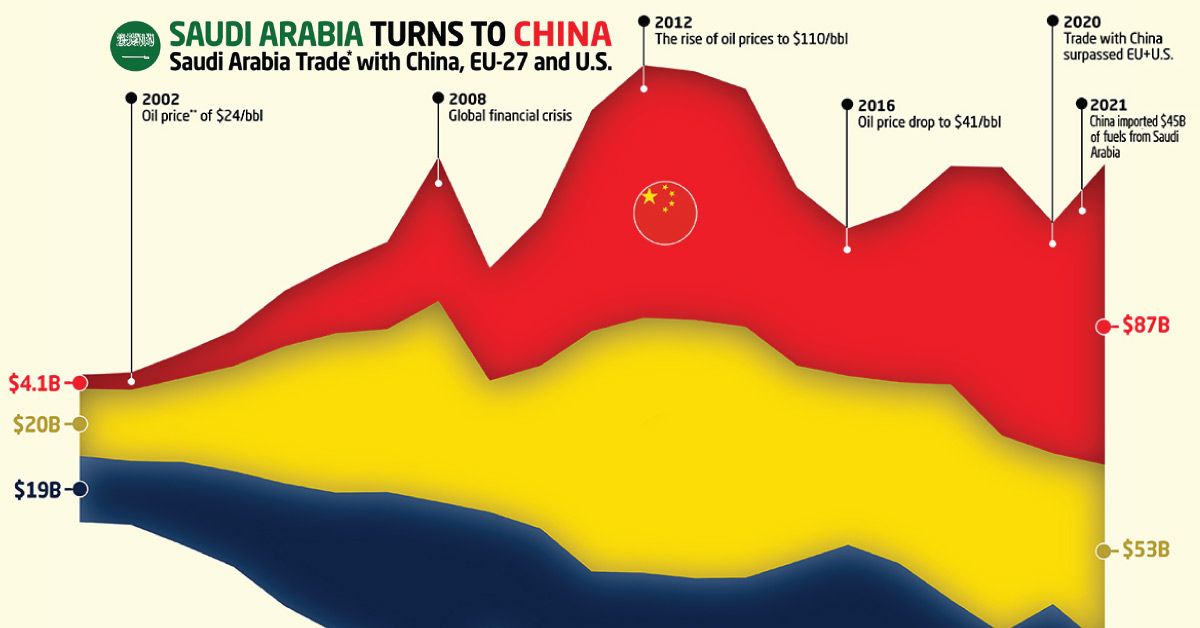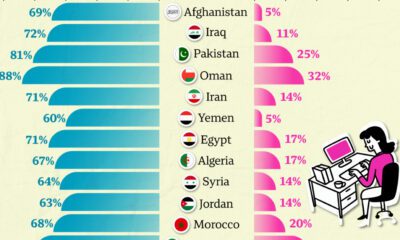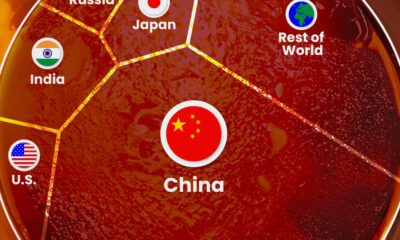Markets
How China Became Saudi Arabia’s Largest Trading Partner
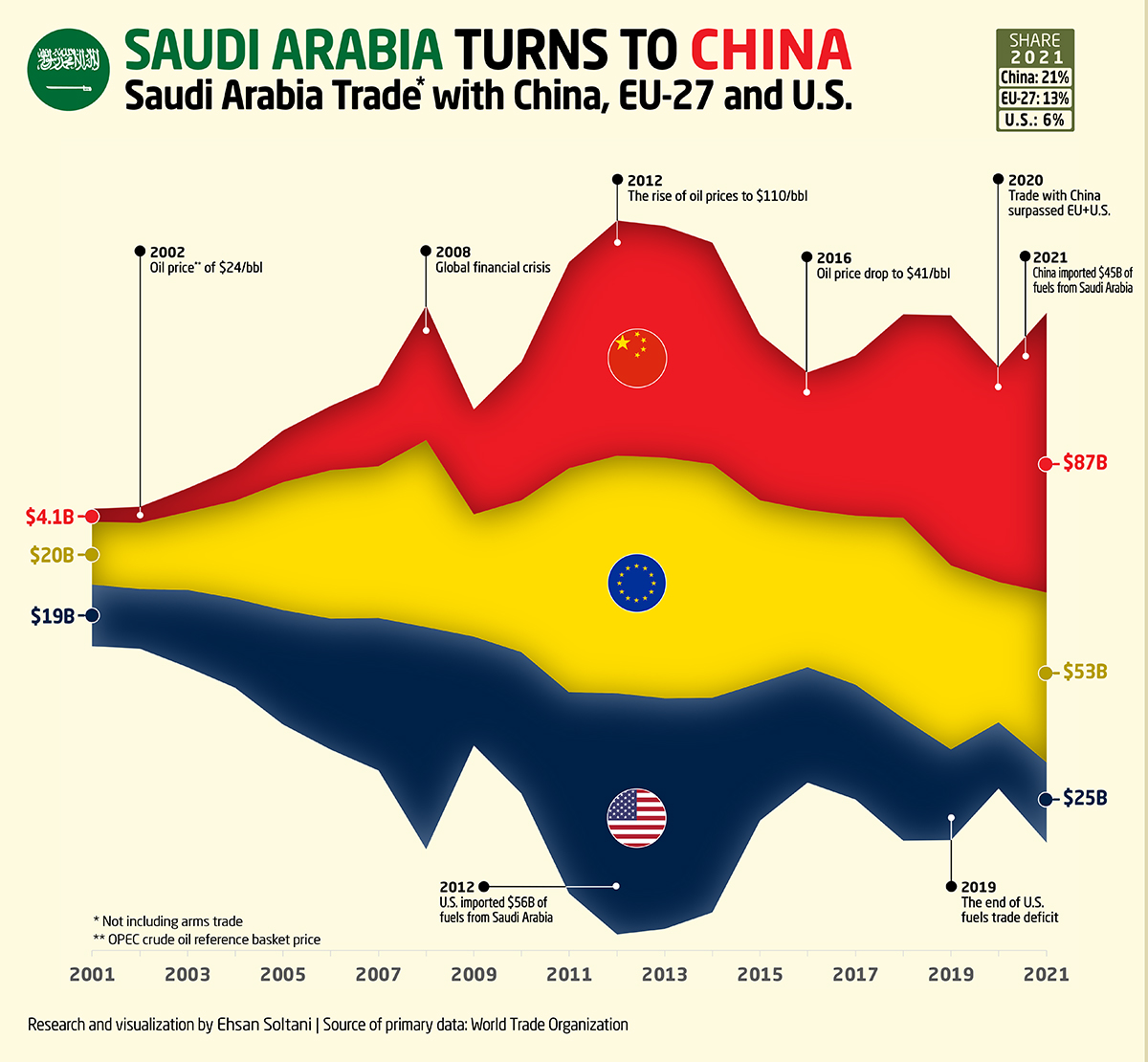
Saudi Arabia’s Trade With China Surpasses the West
Over the past two decades, the economic presence of China has been growing significantly around the world.
The country has already surpassed the U.S. as the largest trading partner of developed nations such as Japan and the European Union.
But the world’s second largest economy is making significant inroads in the Middle East as well. This graphic by Ehsan Soltani uses data from the World Trade Organization (WTO) to chart Saudi Arabia’s trading history with the EU, the U.S, and China.
Evolving Trade Relations
With China’s imports from and exports to Saudi Arabia now exceeding the major oil-producing country’s combined trade with the U.S. and the EU, China has become Saudi Arabia’s dominant trading partner.
| Saudi Arabia Net Trade by Year | With China ($B) | With U.S. ($B) | With EU-27 ($B) |
|---|---|---|---|
| 2021 | $87.3B | $25.1B | $53.1B |
| 2020 | $67.2B | $20.6B | $43.8B |
| 2019 | $78.1B | $28.3B | $57.4B |
| 2018 | $63.5B | $38.2B | $62.7B |
| 2017 | $50.1B | $36.0B | $52.6B |
| 2016 | $42.9B | $36.0B | $49.1B |
| 2015 | $51.8B | $43.2B | $56.9B |
| 2014 | $69.1B | $67.1B | $73.0B |
| 2013 | $72.2B | $72.1B | $75.2B |
| 2012 | $73.3B | $75.3B | $74.3B |
| 2011 | $64.3B | $62.7B | $70.0B |
| 2010 | $43.2B | $44.1B | $47.4B |
| 2009 | $32.6B | $34.0B | $38.2B |
| 2008 | $41.8B | $69.5B | $58.4B |
| 2007 | $25.4B | $47.6B | $47.3B |
| 2006 | $20.1B | $40.9B | $46.2B |
| 2005 | $16.1B | $35.7B | $39.9B |
| 2004 | $10.3B | $27.8B | $30.5B |
| 2003 | $7.3B | $24.1B | $24.4B |
| 2002 | $5.1B | $18.7B | $20.5B |
| 2001 | $4.1B | $19.2B | $19.6B |
Back in 2001, Saudi Arabia’s trade with China was a mere fraction—just one-tenth—of its combined trade with the EU and United States. While the total value of trade was modest at this time, it’s been increasing consistently almost every year since.
By the year 2011, China had surpassed the U.S. for the first time in bilateral trade value with Saudi Arabia. Then by 2018, trade between China and Saudi Arabia surpassed the Middle-Eastern country’s trade with the entire EU.
Fast forward to today, and China has emerged as a larger trading partner with Saudi Arabia than the rest of the West combined.
The Perfect Match?
China’s status as Saudi Arabia’s biggest trading partner makes sense considering its recent economic growth and focus.
China is the largest buyer of crude oil in the world, and it buys more from the Saudi Arabia than anywhere else. Almost half of the $87.3 billion bilateral trade between the two nations in 2021 was comprised of China’s crude oil imports. This accounted for 77% of China’s total imports from Saudi Arabia, which also included goods like plastic—a petroleum product.
Saudi Arabia, meanwhile, imported over $30 billion worth of goods including technological equipment, telephones, and light fixtures.

This article was published as a part of Visual Capitalist's Creator Program, which features data-driven visuals from some of our favorite Creators around the world.
Retail
The World’s Top Retail Companies, by Domestic Revenue
As price pressures and e-commerce reshape shopping behaviors, we show the top retail companies by domestic revenue around the world.

The World’s Top Retail Companies, by Domestic Revenue
This was originally posted on our Voronoi app. Download the app for free on iOS or Android and discover incredible data-driven charts from a variety of trusted sources.
The retail sector plays a vital role in powering economies, contributing $5.3 trillion annually to America’s GDP alone.
Moreover, the industry is America’s biggest private-sector employer, responsible for one of every four jobs, or 55 million employees. Yet in today’s challenging consumer environment, retailers are facing higher e-commerce penetration and inflationary pressures—across an industry notoriously known for razor-thin margins.
This graphic shows the world’s top retail companies by domestic revenue, based on data from the National Retail Federation.
Methodology
To be included in the rankings, companies must engage in a goods-for-consumer resale business accessible to the public and have direct selling operations in a minimum of three countries.
The rankings include both publicly and private companies, and are based on the most recent 52-week period analyzed by the National Retail Federation between January and March 2024. All revenue figures were converted to U.S. dollars.
Ranked: The Top 10 Global Retailers by Domestic Sales
Here are the leading retailers worldwide based on domestic sales as of 2023:
| Ranking | Retailer | Domestic Retail Revenue (USD) | Share of Total Retail Revenue | Headquarters |
|---|---|---|---|---|
| 1 | Walmart | $532.3B | 85% | 🇺🇸 U.S. |
| 2 | Amazon.com | $250.0B | 70% | 🇺🇸 U.S. |
| 3 | Costco | $175.4B | 75% | 🇺🇸 U.S. |
| 4 | The Home Depot | $142.0B | 94% | 🇺🇸 U.S. |
| 5 | Walgreens Boots Alliance | $105.1B | 89% | 🇺🇸 U.S. |
| 6 | Alibaba | $91.5B | 97% | 🇨🇳 China |
| 7 | Apple | $70.9B | 87% | 🇺🇸 U.S. |
| 8 | Aeon | $64.3B | 93% | 🇯🇵 Japan |
| 9 | Schwarz Group | $56.5B | 32% | 🇩🇪 Germany |
| 10 | Rewe | $55.5B | 75% | 🇩🇪 Germany |
Walmart towers ahead as the world’s largest retailer with $532 billion in domestic revenue—more than Amazon.com and Costco combined.
Known for its everyday low prices, Walmart achieves a competitive advantage through pricing goods approximately 25% cheaper than traditional retail competitors. Overall, groceries make up more than half of total sales. While its main customer base is often low and middle-income shoppers, the retail giant is seeing a surge in sales from higher-income customers as shoppers seek out lower grocery prices.
E-commerce giant, Amazon, is the second-biggest retailer globally, commanding nearly 40% of online retail sales in America. Since 2019, the number of Amazon employees has grown from 800,000 to over 1.5 million in 2023.
While the company has tried to introduce online grocery platforms to the market, it has largely fallen flat given its clunky system in a highly competitive market.
Like Amazon, China’s e-commerce juggernaut, Alibaba, stands as a leading global retailer. Overall, 97% of revenues were generated domestically through online marketplaces Taobao and Tmall. In recent years, the company has focused on international expansion, delivering products to 11 markets including America, in just five days.
-

 Economy5 days ago
Economy5 days agoRanked: The Countries Most Dependent on Agricultural Exports
-
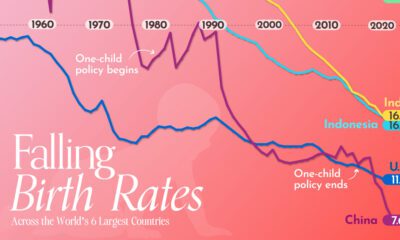
 Demographics2 weeks ago
Demographics2 weeks agoCharted: Declining Birth Rates in the Most Populous Countries (1950-Today)
-
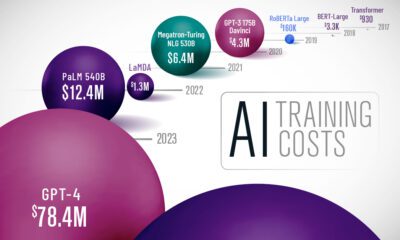
 Technology2 weeks ago
Technology2 weeks agoVisualizing the Training Costs of AI Models Over Time
-
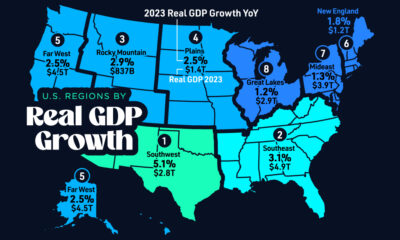
 Maps2 weeks ago
Maps2 weeks agoMapped: The Real GDP Growth of U.S. Regions in 2023
-

 Technology2 weeks ago
Technology2 weeks agoCharted: How Many Data Centers do Major Big Tech Companies Have?
-

 Globalization1 week ago
Globalization1 week agoCharted: Countries Offering Digital Nomad Visas
-

 Politics1 week ago
Politics1 week agoMapped: Unauthorized Immigrants by State
-

 Technology1 week ago
Technology1 week agoVisualizing the 15 Most Valuable Bitcoin Addresses

